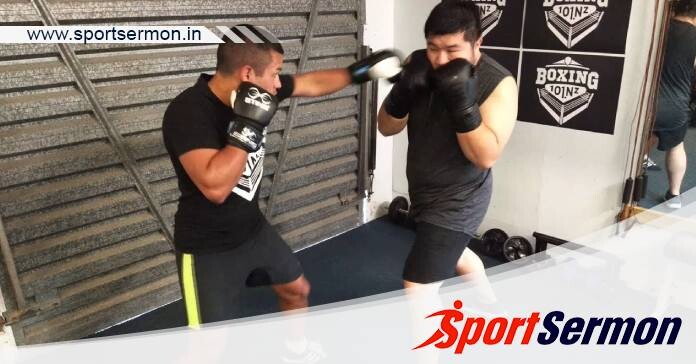Block Boxing Punches: Fundamentally, boxing is a straightforward sport in which competitors try to land more punches than their rivals in the hopes of eventually obtaining a knockout blow or winning the fight by decision. Boxing is perceived by casual onlookers as an aggressive and harsh sport that emphasises offence, but those who are knowledgeable about the finer points of the sport realise that defence is just as vital as, if not more so than, offence.
This fact was brought to light by the super fight between Ryan Garcia and Gervonta Davis in 2023. Garcia significantly outlanded Davis in the first few rounds, but after dropping Garcia with a left hook in the second, Davis was able to capitalise on defensive lapses and win the bout by knockout in the seventh. Floyd Mayweather, who dominated boxing for more than 23 years and relied mostly on his defensive skills in the second half of his career, is Davis’ mentor.
Since even the most careful fighters are unable to roll, sidestep, or slip away from every attack, blocking is the cornerstone of good defence in boxing. While it’s desirable to deflect a hit without receiving any damage, it’s not always possible to predict what your opponent will do next. The greatest thing you can do in these situations is to block boxing punches boxing and lessen the harm they cause. An effective block exposes your opponent to counterattacks while also preventing them from scoring.
All the Information You Need to Block Boxing Punches 
Source: Acidcow.comIn boxing, there are four primary kinds of blocks, and each is most useful in a certain situation. The operation of each of these blocking strategies is broken down as follows:
1. High Block
There are two primary methods for doing the high block, which are among the first defensive strategies that novice boxers learn. In the first, you slide your gloves up until the area that is cushioned over your knuckles sits at eyebrow level on your face. It works well to deflect straight strikes that are targeted at your face.
To avoid punching oneself in the face when blocking a punch, make sure your gloves are in touch with your face.
The second method for doing a high block is to raise your gloves closer to your head’s sides. By blocking in this manner, you let your arms take up most of the force of a blow. Floyd Mayweather frequently employed this strategy when opponents were able to pin him against the ropes. However, compared to the previous version, blocking in this manner exposes you to more body blows.
Additional uses for a high block in boxing include:
- Lead High Block: This entails twisting your torso towards your back leg, pivoting your lead foot, and lifting your lead side glove to head level. It works well to deflect blows that loop, like hooks, at your lead side.
- Rear High Block: This entails spinning towards your lead leg, pivoting your lead leg, and raising your rear hand to head level. It is employed for strikes that loop in from behind you.
2) Low Block
Apart from hand level, low blocks are comparable to high blocks in many ways. Punches targeted at your body are deflected by low blocks. There are two primary methods to carry out a low block:
- Lead Side Low Block: This involves bending at the knees with your hands up, decreasing your centre of gravity. To protect your body, drop your lead elbow and tuck it about hip height, keeping your glove at shoulder height. As you turn to face your back, gently bend your leading leg. Once you have successfully blocked the strike, go back to your normal combat position.
- Rear Side Low Block: As you lower your centre of gravity, tuck your back elbow hip level. To absorb the strike, keep your gloves at shoulder height and turn to face your lead side. After that, take up your usual stance again since lowering your gloves to shoulder height exposes your head to blows.
You might also be interested in reading this: 10 Most Incredible & Iconic Tattoos In Boxing History
3) Catching
Boxers utilise the defensive tactic of “catching” to deflect direct blows. When done correctly, it offers just enough resistance to keep your hand from being forced back into your face during the blow.
When a punch comes your way, lift your glove and meet it with the palm of your hand. Imagine that you are using a glove to catch your opponent’s blow and that their hand is a baseball. If you don’t fully catch the punch, keep your head behind your hand to prevent it from connecting. After taking a blow, instantly return to your fighting position.
4) Parrying
Boxers employ parrying to block direct strikes and expose their opponent to counterattacks. At outside range, the strategy is quite successful. The secret to parrying a punch well is to deflect it just before it reaches its target. When executed properly, it ought to give your opponent plenty of room to reply.
- Lead Side Parry: As soon as an oncoming punch comes into range, hit it downward from your fighting posture. Your elbow should be elevated and your glove perpendicular to the canvas. Proceed with a counterattack, such as a cross.
- Rear Side Parry: While maintaining a high elbow stance, launch a strike downward with your rear hand from your fighting posture.
A strong stance, guard, and footwork are essential.

All of your blocking methods start with a solid boxing stance. Here’s a brief recap of those foundational concepts:
1) The Boxing Position
Proper stance placement establishes the groundwork for both offensive and defensive strategies. Your rear foot should be positioned at around 45 degrees, and your lead foot should be somewhat forward. With your knees slightly bent, equally distribute your weight across both feet. It should be easy for you to drop levels and you should feel balanced in your posture.
2) The Guard
Bring both gloves up to your head. With your lead glove tipped forward, you’re ready to block or deflect any oncoming blows. In order to block hooks and cross punches, the back glove should be positioned closer to the side of your cheek or chin. This stance will protect your head, which is one of the main points of attack in boxing.
3) Footwork
It takes more than just your hands to block. The use of footwork is crucial in defence. Never forget to:
- Keep Your Balance: This keeps you nimble and fast, allowing you to quickly get out of an opponent’s punching range.
- Use Lateral Movement: Shift side to side to avoid being in the direction of lunging assaults, as opposed to going back straight. This will make you a more difficult moving target.
Turn your torso around and pivot on your lead foot if your opponent surges in. By doing this, you will alter your opponent’s angle and make their punch miss.
This is how you can block boxing punches. Let us know your thoughts in the comment section below.

